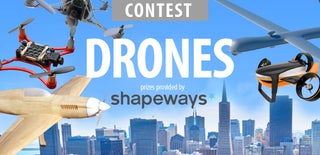Introduction: Drone the Quadcopter
"Drone The Quadcopter" is an featured UAV. I design my project with F450 arm in X-mode design. The full operation takes place via a Flysky FSCT6 remote control unit which gives a better operating range of 800 Meter to 1.2KM.
If you are a beginner in this field then you are on the right place. The ultimate goal of our project is to learn aerial vehicles which can be flyover a long height and over a long range communication. By learning this technology can be used for search and rescue, fire-fighting, law enforcement, military, and news reporting by being able to deploy aerial correspondence much faster than conventional helicopters.
Step 1: Watch Video
Step 2: Required Components
- Flysky FSCT6 RC Transmitter and receiver
- KK2.1 Flight controller board
- F450 Quadcopter arm kit
- 4 X 1000KV A2212 BLDC motor
- 4 X ESC
- 4 X 1045 Propeller
- Four legs for quadcopter stand
- LiPo battery 2200mAh/35C
- LiPo battery charger
- Connecting cables
- Heat shrink tubes etc.
Step 3: Connect Motors to Arm
Start the project by connecting each motors to each arm with screws.
Step 4: Solder the ESC to the Bottom PCB
Solder the ESC(electronic speed controller) to the bottom support PCB. Remember to solder the power supply wires only.
Step 5: Connect Bottom PCB to Arm and Legs
Step 6: Install Battery and RC Receiver
Step 7: Cover the Top Support
Step 8: Place the Flight Controller Board
Place the flight controller board on the top supporting base using hot glue or any adhesive material.
Step 9: Soldering Motor Terminals to ESC
There are three terminals of motors. Connect these terminals to the terminals of ESC output. Two motor have a clockwise rotation and the rest two motors have a counter-clockwise rotation. After connection of motors and ESCs, if you want to change the direction of any motor then simply replace two terminals except the middle one.
Step 10: Connecting Cables
Connect cables among all the components as per requirement. Make sure for proper connection. Do not connect battery without ensuring for proper connection otherwise you'ill face a damage.
Step 11: Matching Block Diagram
Just take a look on the block diagram. The block diagram provides a connection methodology.
Step 12: Powering the Quadcopter
Finally connect the full charged battery power terminals to the bottom PCB power terminals. You can see the home screen on the flight controller board display as shown in the picture above. You can not operate the motor using transmitter untill you follow the arming process. This is designed for safety purpose. By pressing the "MENU" button on the flight controller you can see a number of settings.
There is a battery connecting point on the flight controller for measuring the battery voltage. This point is connected directly to the battery power supply.
Step 13: Selecting the Quadcopter Layout
There are different kind of drone layouts but in my case it is an X-copter so I chose the quadcopter X-mode.
Step 14: Show Motor Layout
After selecting the quadcopter layout, check the motor layout to see that the motor's direction of rotation are correctly installed otherwise take a proper repair of connection.
Step 15: Accelerometer Calibration
For the first time of operation of your quadcopter, you need to calibrate the accelerometer only one time. It is very simple and essential setting. Just place the quadcopter on a plane surface and press the required buttons.
Step 16: Checking Accelerometer and Gyroscope
Move the quadcopter in different position. You can see the changing values of accelerometer and gyroscope reading.
Step 17: Receiver Test
Here we need to set the transmitter for putting these values to zero or nearer to zero position. Auxiliary channel shows maximum value as we use one channel for self level. Take a look on the transmitter manual, We have configured the transmitter at MODE-2(rudder throttle at left joystick).
Step 18: Mode Setting
This is also an important setting which shows that the self leveling takes place whenever the auxiliary channel is at ON/Maximum position.
Step 19: Self Level Setting
If gain is high that means an small change in joystick control can make a higher change in drone operation. So in order to safe utilize the self level function you have to calibrate these setting till you get a proper balance during flying.
Step 20: PI Editor
Here I am using the default settings after factory reset.
Step 21: Stick Scaling
Here I am using the default settings after factory reset.
Step 22: Miscellaneous Settings
Step 23: Mixer Editor
Here I am using the default settings after factory reset.
Step 24: Extra Settings
We 'ill not discuss about these settings as we did not use this in this quadcopter. If you make any wrong setting or confused to repair then just use the "factory reset" to put all the values to default. In my case, almost the settings are on default values.
Step 25: Install the Propellers
This is the last finishing step. Here we follow the arming procedure for motor rotation. For transmitter(in mode-2), move the joystick left side control(Rudder) to one side for a few seconds. If arming is successful then you can see "ARMED" on the flight controller display. For disarming, move the transmitter joystick left side control(Rudder) to another side for a few seconds.
If you have tested & configured all things then finally install the propellers. That's it and the quadcopter is ready to fly over the sky.
Best of luck.

Participated in the
Backyard Contest 2016

Participated in the
Drones Contest 2016













